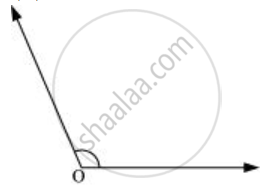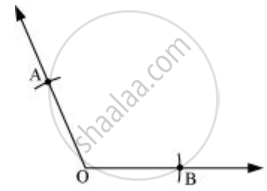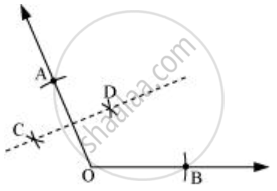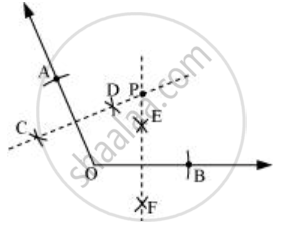Advertisements
Advertisements
प्रश्न
Draw any angle with vertex O. Take a point A on one of its arms and B on another such that OA = OB. Draw the perpendicular bisectors of `overline"OA"` and `overline"OB"`. Let them meet at P. Is PA = PB ?
उत्तर
- Draw any angle whose vertex is O.

- With a convenient radius, draw arcs on both rays of this angle while taking O as centre. Let these points be A and B.

- Taking O and A as centres and with radius more than half of OA, draw arcs on both sides of OA. Let these be intersecting at C and D. Join CD.

-
Similarly, we can find the perpendicular bisector `overline"EF"` of `overline"OB"`. These perpendicular bisectors `overline"CD"` and `overline"EF"` will intersect each other at P.
Now, PA and PB can be measured. These are equal in length.

APPEARS IN
संबंधित प्रश्न
Draw a line segment AB = 5.5 cm. Mark a point P, such that PA = 6 cm and PB = 4.8 cm. From point P, draw a perpendicular to AB.
Draw a line segment of given length and construct a perpendicular bisector to line segment using scale and compass
58 mm
Only one perpendicular bisector can be drawn to a given line segment.
It is possible to draw two bisectors of a given angle.
Infinitely many perpendicular bisectors can be drawn to a given ray.
Draw a line segment of length 6.5 cm and divide it into four equal parts, using ruler and compasses.
Bisect ∠XYZ of figure.
Draw the perpendicular bisector of `overline"XY"` whose length is 10.3 cm.
- Take any point P on the bisector drawn. Examine whether PX = PY
-
If M is the midpoint of `overline"XY"`, what can you say about the lengths MX and XY?
Draw a circle with centre C and radius 3.4 cm. Draw any chord `overline"AB"`. Construct the perpendicular bisector of `overline"AB"` and examine if it passes through C.
Repeat Question 6, if `overline"AB"` happens to be a diameter.
